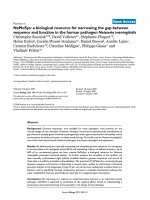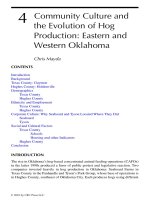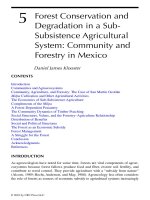Computational techniques for simulating the interactions between peptides and carbon nanotubes
Bạn đang xem bản rút gọn của tài liệu. Xem và tải ngay bản đầy đủ của tài liệu tại đây (1.24 MB, 174 trang )
COMPUTATIONAL TECHNIQUES FOR SIMULATING
THE INTERACTIONS BETWEEN PEPTIDES AND
CARBON NANOTUBES
CHENG YUAN
NATIONAL UNIVERSITY OF SINGAPORE
2007
COMPUTATIONAL TECHNIQUES FOR
SIMULATING THE INTERACTIONS BETWEEN
PEPTIDES AND CARBON NANOTUBES
CHENG YUAN
(B. S., FUDAN UNIVERSITY, CHINA)
A THESIS SUBMITTED
FOR THE DEGREE OF DOCTOR OF PHILOSOPHY
DEPARTMENT OF MACHANICAL ENGINEERING
NATIONAL UNIVERSITY OF SINGAPORE
2007
Acknowledgements
i
Acknowledgements
I would like to express my deepest gratitude and appreciation to my supervisor,
Professor Liu Gui-Rong for his dedicated support, invaluable guidance, and
continuous encouragement in the duration of the study. His influence on me is far
beyond this thesis and will benefit me in my future research work. I am much grateful
to my co-supervisor, Dr. Lu Chun, for his inspirational help and valuable guidance in
my research wrok. I would also like to thank Mr. Li Zi-rui and Dr. Mi Dong for their
helpful discussion, suggestion, recommendations and valuable perspectives.
To my friends and colleagues in the ACES research center, Ms Zhang Ying-Yan,
Dr. Zhang Gui-Yong, Dr. Dai Ke-Yang, Dr. Li Wei, Dr. Deng Bin, Mr. Zhou
Cheng-En, Dr. Zhao Xin, Mr. Kee Buck Tong Bernard, Mr. Zhang Jian, Mr. Song
Cheng-Xiang, Mr. Khin Zaw, Mr. Luo Rongmo, I would like to thank them for their
friendship and help.
To my family, I appreciate their love, encouragement andsupport. Especially to
my husband, Mr. Li Ang, it is impossible for me to finish this work without his
support and encouragement.
I am grateful to the National University of Singapore for granting me the
research scholarship which makes my study in NUS possible. Many thanks are
conveyed to Center for Advanced Computations in Engineering Science (ACES) and
Department of Mechanical Engineering, for their material support to every aspect of
this work.
Table of contents
ii
Table of Contents
Acknowledgements i
Table of Contents ii
Summary vi
Nomenclature viii
List of tables xiii
List of figures xvi
Chapter1 Introduction 1
1.1 Background information for Carbon nanotubes (CNTs) and peptides 1
1.1.1 General overview of CNTs 1
1.1.1.1 Molecular structure of CNTs 1
1.1.1.2 Properties of CNTs and their applications 3
1.1.2 Proteins and peptides 5
1.2 Functionalization of CNTs with Biomolecules 8
1.2.1 Experimental approaches 8
1.2.2 Simulation approaches 11
1.3 Molecular simulation models based on different levels of description 11
1.3.1 The atomic model 12
1.3.2 The coarse-grained hydrophobic-polar (HP) lattice model 17
1.4 Objectives and significance of this study 20
1.5 Main contribution of the thesis 22
1.6 Organization of the thesis 23
Chapter 2 Molecular dynamics (MD) simulation based on the all-atom model. 28
2.1 Modeling and simulation methods 29
Table of contents
iii
2.1.1 Molecular Mechanics and empirical force fields for molecular simulation
29
2.1.2 The criteria of peptide selection 34
2.1.3 Generation of initial structures 34
2.1.4 Energy Minimization 35
2.1.4.1 Statement for the energy minimization problem 36
2.1.4.2 Derivative Minimization methods 38
2.1.5 Integration of the motions of particles using finite difference method. 41
2.1.6 Statistical mechanics ensembles 46
2.1.6.1 Implementation of statistical ensembles 46
2.1.6.2 Thermodynamic average 49
2.1.7 Implementation details 51
2.2 Results and Discussion 52
2.2.1 Diverse propensities 52
2.2.2 Energetics of peptide-CNT interaction 54
2.2.3 Impacts of CNT size 56
2.2.4 Correlations between hydrophobicities and propensities 57
2.3 Remarks 58
Chapter 3 Estimation of interaction free energy 70
3.1 Methods 71
3.1.1 Generation of initial structures 71
3.1.2 MD simulation in explicit solvent 73
3.1.3 Calculations of energy contributions 73
3.1.3.1 Implementation of the GB model 73
3.1.3.2 Evaluation of binding free energy from its components 77
3.2 Results 79
3.2.1 Peptides display diverse propensities 79
3.2.2 Error analysis of the systems in explicit solvent 80
3.2.3 Free energy calculations and energetic analysis 80
Table of contents
iv
3.2.4 The effect of aromatic rings 83
3.3 Discussions 85
3.3.1 Functionalizing CNTs with peptides 85
3.3.2 Calculations of the entropic term 86
3.3.3 Calculations of free energy of peptides encapsulated into SWCNTs 86
3.3.3.1 Implementation details 86
3.3.3.2 Results 88
3.3.4 The influence of hydrophobicities of amino acids 89
3.3.5 Impact of the aromatic ring 91
3.4 Remarks 92
Chapter 4 Thermodynamic studies based on a hydrophobic-polar (HP) lattice
model 105
4.1 HP lattice model using Monte Carlo (MC) simulation methods 106
4.1.1 2D HP lattice model for modeling peptide-CNT interactions 106
4.1.2 MC simulation of peptide-CNT interactions 110
4.1.2.1 Random number generators 111
4.1.2.2 Implementation of the Metropolis algorithm 112
4.1.3 Molecular Simulation of Ensembles 115
4.1.4 Calculations of thermodynamics for peptide-CNT binding process 117
4.2 Results 119
4.2.1 Thermal unfolding of model peptide 119
4.2.2 Thermodynamics of peptides interacting with CNTs 121
4.2.2.1 The selection criteria for the interaction energy parameters and the
analysis of thermodynamic quantities 121
4.2.2.2 Conformational changes of peptide chain binding to CNT surface 124
4.3 Discussions on comparison of MD and MC methods 126
4.4 Remarks 127
Chapter 5 Conclusions and Future work 134
5.1 The major conclusion from the study 134
Table of contents
v
5.2 Recommendations for future research work 136
References 138
Publications arising from thesis 152
Summary
vi
Summary
The exceptional properties of carbon nanotubes (CNTs) facilitate their wide
application in a number of fields in physics, chemistry, and biomedicine. Although the
marvellous properties of CNTs have triggered great interest of researchers to explore
potential applications of CNTs, the mechanism of CNTs interacting with biomolecules
still remains unclear.
This thesis focuses on investigation of interaction mechanism between peptides
and CNTs based on different levels of molecular description. Computational strategies
adopting either all-atom model or coarse-grained model are implemented. The major
works reported in this thesis are listed as follows
1) An all-atom model is developed to study self-insertion behaviors of different
peptides into SWCNTs in explicit water environment using molecular dynamics (MD)
simulation. The conformational changes of the peptide and energetics of the
interaction are traced. Variations in affinity of different peptides for single-walled
carbon nanotubes (SWCNTs) are also observed.
2) The Molecular Mechanics-Generalized Born Surface Area (MM-GBSA)
method is extended to evaluate the free energy of peptides interacting with CNTs. The
relative binding affinities are compared with the experimental results to validate the
Summary
vii
model. The physical mechanism involved in this process is then studied in detail.
Other effects that may influence peptide-CNT interaction are also investigated.
3) In order to obtain a general view of different binding affinity of hydrophobic
and hydrophilic amino acids for the CNTs, binding free energy between each amino
acid and the same CNT is estimated individually based on the all-atom model. The
relative binding affinities of amino acids from the hydrophobic and hydrophilic groups
are compared.
4) A coarse-grained hydrophobic-polar (HP) lattice model is developed
performing MC simulation to observe the macroscopic properties of the adsorption of
peptides onto CNT surfaces. The preliminary energy parameters are developed
according to experimental observations and numerical results from the all-atom model.
The thermodynamic quantities and conformational characteristics of peptides are also
clarified.
Through these studies I am not only able to explore the detailed conformational
properties and energetics of peptides interacting with CNTs, but also the peptide-CNT
interaction mechanism from both microscopic and macroscopic views. The results
obtained through this study provide valuable information on the potential applications
of CNTs in the field of drug delivery, drug design and protein control.
Nomenclature
viii
Nomenclature
a
particle’s acceleration
A
Helmholtz free energy;
accessible surface area
ij
A
the area of sphere
i buried inside sphere
j
A
ensemble average value of property
A
1
c
the constant representing the initial velocity of the
particle
2
c
the constant representing the initial position of the
particle
d
the center of mass distance between the peptide
and the nanotube at instant simulation time
0
d
the initial center of mass distance between the
peptide and the nanotube
des
E
desired energy
MM
E
gas-phased molecular mechanics energy
internal
E
the internal energy
ele
E
the electrostatic energy
vdw
E
the van der Waals interaction energy
Nomenclature
ix
i
E
potential energy of HP lattice model at certain
state
totalele
E
_
the energy sum of
ele
E and
pol
G
MM
E
gas-phased molecular mechanics energy
tot
i
f
the sum of inter-molecular forces and external
forces
F
the force acting on the particle
s
cnt
G
,
s
p
eptide
G
,
s
complex
G
free energy of the peptide, the carbon nanotube,
and the peptide-nanotube complex solvated in
water, respectively
GΔ
interaction free energy
sol
G
the solvation free energy
nonpol
G
polar energy
pol
G
nonpolar energy
h
Planck’s constant
()H Γ
Hamiltonian
k
θ
force constant for angle bending potential
r
k
force constant for bond stretching potential
B
k
Boltzmann constant
K
kinetic energy
MU
K
equilibrium constant
l
bond length
Nomenclature
x
0
l
the reference bond length
m
particle’s mass
k
N
the total number of contact pairs in a certain HP
lattice structure
N
number of particles
mn
p
the trial move
p
momentum
P
pressure
i
q
atomic partial charges
NVE
Q
,
NVT
Q
,
VT
Q
μ
,
NPT
Q
the partition function for different ensembles
ij
r
distance between atoms
r
displacement of the particle
i
R
atomic radius
i
S
the surface area of the isolated sphere
S
entropy
t
time
*
T
the dimensionless temperature
T
temperature
()U r
potential energy
ν
particle’s velocity
V
box of volume
n
V
the rotational barrier height
Nomenclature
xi
i
w
occurrence of each amino acid in proteins
W
internal virial
Z
partition function of the system
i
α
effective Born radius
mn
α
stochastic matrix element between state
m and
state
n
β
inverse temperature (1 / )
B
kT
Γ
the set of particle positions and momenta
),(
jiS
AA
γ
interaction potential energy between the two
amino acids residues for HP lattice model
0
ε
solvent dielectric constant
ε
well depth;
intermolecular potential energy parameter
σ
the collision diameter
θ
bond angle
0
θ
reference bond angle
μ
the chemical potential of the simulated system
κ
Debye-Huckel screening parameter
i
η
intrinsic radius of atom
i
m
ρ
the probability that the system is in state
m
ξ
random number (usually in range 0 to 1)
ens
Ψ
the characteristic thermodynamic function
Nomenclature
xii
ω
torsion angle
)(
i
EΩ the density of states with energy
i
E
mn
π
the probability of moving from
m
to state
n
List of tables
xiii
List of tables
Table 1.1 Abbreviations for amino acids, hydrophobicity (by K-D
method) and the occurrence of the amino acids in proteins.
25
Table 2.1 The properties of simulated peptides. For hydropathy
distributions, each amino acid on the peptide is indicated as
either ‘H’ (hydrophobic) or ‘P’ (polar), according to K-D
method.
59
Table 2.2 The list of the simulated peptides, type of SWCNTs, number
of surrounding water molecules as well as the initial distance
between the most adjacent two atoms of the peptide and the
SWCNT along the nanotube axis.
60
Table 2.3 The list of the simulated peptides classified into three classed
based on the insertion behaviors.
60
Table 3.1 Sequences of five 12-residue peptides, as well as their
average hydrophobicity. The hydrophobicity values of amino
acid residues are calculated using the K-D method.
93
Table 3.2 The properties of simulated peptides. For hydropathy
distributions, each amino acid on the peptide is indicated as
either ‘H’ (hydrophobic) or ‘P’ (polar), according to K-D
method.
93
Table 3.3 The average values of potential energies and their standard
deviations over the last 500ps for simulated systems solvated
in explicit TIP3P water molecules.
94
Table 3.4 (a)-(e) The energy contributions of the five peptides binding
to SWCNTs, and the standard deviations of the energy terms.
94
List of tables
xiv
Table 3.5 The comparison of energy contributions of peptides binding
to SWCNTs.
97
Table 3.6 Relative binding free energies between pep18 and pep19, and
pep20 and pep21.
G
Δ
Δ of pep18-pep19 is calculated as
(18 ) (19 )
G G pep SWCNT G pep SWCNTΔΔ = Δ − − Δ −
,
and
the same with other energy contributions and that of
pep20-pep21.
97
Table 3.7 (a)-(c) The energy contributions of the three peptides
inserting into to SWCNTs, and their standard deviations of
the energy terms, respectively.
98
Table 3.8 The comparison of energy contributions of peptides inserting
into SWCNTs.
99
Table 3.9 Binding free energies and the standard deviations estimated
using MM-GBSA method. The energy unit in this table is
kcal/mol. The free energy of the SWCNT for all the twenty
systems is
1653.5895
s
cnt
G =
kcal/mol and the standard
deviation is 8.7468 kcal/mol. The binding free energy is
estimated as
)(
s
aa
s
cnt
s
complex
GGGG +−=Δ
.
The lower value of
GΔ
correlates to a stronger binding affinity.
100
Table 4.1 Thermodynamic quantities of sequence I in bulk water at
different temperatures. In the table
*
T
is the dimensionless
temperature,
U
is the internal energy,
MU
G
Δ
is the
standard free energy change,
S is the conformational
entropy of the peptide,
A
is the Helmholtz free energy,
M
ρ
is the probability that the system lies in the
lowest-accessible energy of the system. The energy unit is
ε
.
129
List of tables
xv
Table 4.2 Thermodynamic properties of sequence I binding to the CNT
using different parameters at representative temperatures. In
the table
M
E is the lowest-accessible potential energy.
Other quantity units can be referred to Table 4.1.
129
List of figures
xvi
List of figures
Figure 1.1 Structure of single-walled carbon nanotubes (SWCNT) and
multi-walled carbon nanotubes (MWCNT).
26
Figure 1.2 Structure of single-walled carbon nanotubes (SWCNT) and
multi-walled carbon nanotubes (MWCNT).
26
Figure 1.3 Structure of single-walled carbon nanotubes (SWCNT) and
multi-walled carbon nanotubes (MWCNT).
27
Figure 2.1 Illustrations for potential energies between particles. 61
Figure 2.2 Strategies for implementation of simulation procedure. 62
Figure 2.3 The RMSDs for the backbone atoms on pep3 against the
simulation time.
63
Figure 2.4 The snapshots of the conformation of oxytocin (pep3)
insertion into SWCNT at different simulation time: (a)
initial structure, (b) 50ps, (c) 100ps, (d) 500ps, (e) 2ns. (f)
shows the final structure (2ns) viewed along the axis of
nanotube. The images are created with DS ViewerPro 5.0
software (Accelrys Inc., San Diego, CA)
64
Figure 2.5 The snapshots of the final structure of pep13 interacting with
SWCNT at simulation time of 2ns. The images are created
with DS ViewerPro 5.0 software (Accelrys Inc., San Diego,
CA)
65
Figure 2.6 Normalized Center of Mass (COM) distances between the
peptide and SWCNT as the function of MD simulation time.
d0 is the initial COM distance between the peptide and the
SWCNT, and d is the distance at the Corresponding
65
List of figures
xvii
simulation time.
Figure 2.7 (a) Potential energy of the simulated oxytocin
(pep3)-SWCNT system as the function of COM distance
between SWCNT and pep3. (b) Energy sum of the van der
Waals energy and the electrostatic energy (non-bonded
interaction energy) as the function of COM for
pep3-SWCNT system. (c) The difference between potential
energy and non-bonded interaction energy as the function of
COM distance between pep3 and SWCNT. The half length
of the nanotube is 12.9
Å
.
66
Figure 2.8 (a) Potential energy of the pep13-SWCNT system as the
function of COM distance of SWCNT and pep13. (b)
Energy sum of the van der Waals energy and the
electrostatic energy (non-bonded interaction energy) as the
function of COM for pep13-SWCNT system. (c) The
difference between potential energy and non-bonded
interaction energy as the function of COM distance between
pep13 and SWCNT. The half length of the nanotube is 14.6
Å
.
67
Figure 2.9 Normalized COM distances between the peptide and
nanotube as the function of simulation time. Solid lines
represent the cases with normal van der Waals parameters,
dash lines are for the cases with the modified van der Waals
parameters.
68
Figure 2.10 Snapshots of conformation of oxcytocin and (12, 12) type
SWCNT at simulation time of 2ns. The diameter of the
nanotube is 16.1
Α
&
, smaller than that of (14,14) in Figure
2.4.
68
Figure 2.11 Normalized Center of Mass (COM) distances between the
peptide and SWCNT as the function of MD simulation time
for the same peptide inserting into SWCNTs of different
69
List of figures
xviii
length.
Figure 2.12 Average hydrophobicity for simulated peptides. Higher
values of the average hydrophobicity imply that the peptides
are more hydrophobic. Sequence numbers of peptides are in
accordance as listed in Table 1. Pep1 through pep5 rapidly
insert into the SWCNTs, pep6 through pep11 partially insert
into SWCNTs or insert completely with slow speed, pep12
through pep17 fail to insert into SWCNTs.
69
Figure 3.1 The strategy of estimating interaction free energy between
two states.
101
Figure 3.2 Snapshots of final structures of peptides and
peptide-SWCNT complex in water solvent. (a) pep22 (b)
pep22-SWCNT complex (c) pep20 (d) pep20-SWCNT
complex. The images are created with DS ViewerPro 5.0
software (Accelrys Inc., San Diego, CA)
102
Figure 3.3 The RMSDs for the backbone atoms on pep20. The dotted
lines represent the unbound peptide and the solid lines
represent the peptide in the complex.
103
Figure 3.4 The comparison of binding free energies with experimental
results. The binding free energies are drawn as their
absolute values (kcal/mol). The plaque-forming units from
experimental results are scaled linearly in relation to the
absolute values of the binding free energy of pep20. Larger
GΔ and plaque-forming unit values correspond to higher
binding affinities.
103
Figure 3.5 The scheme for calculating energy potential of residue Trp
on the surface of a SWCNT. The residue containing an
aromatic ring is moved along two directions for positioning
and energy calculations.
104
Figure 3.6 Snapshots of final structures of peptides and 104
List of figures
xix
peptide-SWCNT complex in water solvent. (a) pep4 (b)
pep4-SWCNT complex (c) side view of pep4-SWCNT
complex. The images were created with DS ViewerPro 5.0
software (Accelrys Inc., San Diego, CA)
Figure 4.1 The Verdier–Stockmeyer moves allowed for peptide
conformational transition.
130
Figure 4.2 The initial conformation of model peptide I. The filled
cycles represent hydrophobic elements, while the unfilled
ones represent polar elements.
130
Figure 4.3 The ensemble averaged number of hydrophobic contacts
>< Q
,
as the function of the dimensionless temperature,
*
T
.
131
Figure 4.4 Initial structures of peptide sequence I (left) and sequence II
(right) interacting with model CNT surface. Peptide
sequence I has eight hydrophobic residues and sequence II
possesses five. The filled cycles represent hydrophobic
elements while unfilled ones represent the polar elements.
131
Figure 4.5 The representative conformations of sequence I (left) and
sequence II (right) shortly after their binding to the CNT
surface. The peptide-CNT interaction energy parameters
are
5),(
−
=
CH
S
γ
ε
,
ε
γ
4),(
−
=
CP
S
.
132
Figure 4.6 Representative conformations of sequence I (left) and
sequence II (right) binding to CNT surface at
6.1
*
=T at
6.1
*
=T
.
The peptide-CNT interaction energy parameters
are 5),(
−
=
CH
S
γ
ε
,
ε
γ
4),(
−
=
CP
S
.
132
List of figures
xx
Figure 4.7 Illustrations of the averaged number of monomers in the
first and the fourth layers adjacent to CNT surface against
the MC cycles for peptide I at
6.1
*
=T
(fitted using fourth
order polynomials).
133
Chapter 1 Introduction
1
Chapter1
Introduction
1.1 Background information for Carbon nanotubes (CNTs) and peptides
1.1.1
General overview of CNTs
Carbon nanotubes (CNTs) are hollow cylindrical tubes consisting of webs of
carbon atoms. Since their discovery in 1991 (Iijima, 1991), CNTs have stimulated
ever-broader research activities in science and engineering devoted to production and
application of various CNTs. The outstanding properties of CNTs such as high
mechanical strength and remarkable electronic structure make CNTs special in
applications in a vast variety of fields. A number of excellent reviews on general
properties of CNTs are available (Harris et al., 1999; Dresselhaus et al., 1996;
Dresselhaus et al., 2001), here I make this effort with emphasis on the applications of
CNTs in biomedical areas.
1.1.1.1 Molecular structure of CNTs
CNTs are normally classified into two categories: single-walled carbon
nanotubes (SWCNTs) and multi-walled carbon nanotubes (MWCNTs). SWCNTs are
made from a graphite sheet rolled into a cylinder, while MWCNTs are composed of
multiple concentric graphite cylinders, as illustrated in Figure 1.1. Compared with
Chapter 1 Introduction
2
MWCNTs, SWCNTs are more expensive and difficult to manufacture and clean, but
they have been of great interest to researchers owing to their specific electronic,
mechanical, and gas adsorption properties (Ebbesen et al., 1997).
CNTs can be considered as rolled-up graphite sheets. When carbon atoms
geometrically combine together to form graphite,
2
sp hybridization occurs (Brown et
al., 1999). Different types of CNTs can be characterized by a linear combination of
base vectors
a and b of the hexagon, or n m
=
+rab , where n and m are integers
of the vector equation (Thostensona et al., 2001; Qian et al., 2002) as shown in Figure
1.2. The values of n and m uniquely determine the chirality, or twist style of the
nanotube. Three major categories of CNTs can be defined based on the value of n and
m. If
mn = , the CNT is armchair, if 0
=
n or 0
=
m , the CNT is classified as
zigzag. When
mn ≠ , the CNT is generally chiral. The chirality affects the
conductance, the density, the lattice structure, and therefore affects other properties of
the nanotube. A SWCNT is considered metallic if the value
mn
−
is divisible by
three. Otherwise, the nanotube is semiconducting. Consequently, when tubes are
formed with random values of n and m, it is expected that two-thirds of nanotubes
would be semi-conducting, while the other third would be metallic, which happens to
be the case. Representative configurations of the three types of CNTs are illustrated in
Figure 1.3.
Given the chiral vector ),(
mn , the diameter d and the chiral angle
θ
of a
carbon nanotube can be determined as
Chapter 1 Introduction
3
22 1/2
-1
22
d (n m nm) *0.0783 nm
3
sin
2( )
m
nnmm
θ
⎧
=++
⎪
⎡⎤
⎨
=
⎢⎥
⎪
++
⎣⎦
⎩
(1.1)
1.1.1.2 Properties of CNTs and their applications
Many efforts have been made in order to investigate the mechanical properties of
CNTs. For example, they were found to be bent mechanically by mechanical milling
or embedding in a polymeric resin (Ajayan et al., 1994; Iijima et al., 1996; Chopra et
al., 1995; Ruoff et al., 1995). This flexibility property was also predicted through
theoretical calculations (Overney et al, 1993; Robertson et al., 1992; Tersoff, 1992).
Treacy et al. (1996) first investigated the elastic modulus of isolated multi-walled
nanotubes by measuring the amplitude of their intrinsic thermal vibration through the
transmission electron microscope (TEM). Direct measurement of the stiffness and
strength of individual, structurally isolated multi-wall CNTs has also been performed
with an atomic-force microscope (AFM) (Wong et al., 1997). High Young’s modulus
of CNTs was observed through these measurements. This high Young’s modulus
implies that CNTs are very strong material. On the other hand, the mechanical
properties of composite materials containing CNTs are expected to be greatly
enhanced, although those materials will not be as robust as individual nanotubes.
CNTs also possess unique electrical properties. These properties are sensitive to the
orientation of the hexagonal graphite lattice because it determines the density of electron
states at the Fermi level (Gao et al., 2004). Hamada et al. (1992) found theoretically that
all the armchair nanotubes are electronic conductors, while zig-zag nanotubes are









